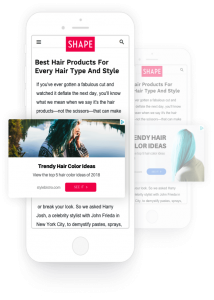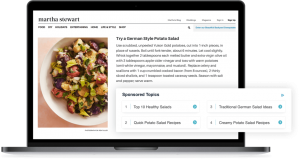In the dark ages of the SEO era, when bloggers and webmasters were still familiarizing themselves with the process and its functionality, certain tactics and strategies had become industry standards.
The era I’m talking about is the one where Google AdSense was heavily built into the foundation of a blogger’s strategy. The “legacy” tactics associated with this approach can still be found in the way modern publishers think about SEO and branding strategy. However, AdSense’s limited customizability can hold back publishers. This needs be addressed and rooted out.
Before assuming AdSense is the best monetization partner for you, consider these four warning signs. If you’re guilty of practicing any of these points, it’s time you re-evaluated your monetization partner and strategy.
1. You haven’t considered other platforms
It’s no secret that AdSense as a standalone monetization stream isn’t enough to earn substantial revenue. Most solopreneurs that still operate in the “blogosphere” have understood for years that it is important to branch out and diversify revenue streams. So there’s nothing revolutionary about this concept.
Most of the focus on diversification has been on developing products to sell, with eBooks being a gold standard. This is great advice, even if it can become a bit boilerplate at times. But we’re not talking about selling products today. We’re talking about contextual advertising, which means placing relevant ads on your site that fit in with the content of your page. When it comes to contextual advertising, too many people still aren’t considering their other options.
Media.net, the second largest contextual advertising business worldwide by revenue, is a good place to start experimenting. The platform uses machine-learning algorithms to predict user intent, based on the content of your pages, and serves ads based on the associated keywords. With Media.net you get exclusive access to Yahoo! Bing’s $6 billion worth of search demand. This allows you to leverage quality advertisers even if you are in a smaller niche.
Performance is obviously different for every site, but Perrin Carrell of AuthorityHacker claims Media.net ads earns them 5x as much as AdSense ads, and Jon Dykstra of FatStacksBlog reported that some Media.net ad placements were earning more revenue than all other ad networks.
One of the biggest advantages of Media.net ads is that their ads are heavily customizable. Sizes and designs can be designed to match your site so that they are native to your content and inline with your branding, resulting in higher engagement and revenue. Native ads are a great way to offer your readers an uninterrupted experience since these ads look like a natural extension of your website. In fact, these ads are also mobile responsive, which means more revenue for you.
Media.net Native Ad Unit
Media.net Contextual Ad Unit
From there, you can also consider ad servers like the Google Ad Manager (formerly DoubleClick For Publishers) and OpenX. Ad server platforms like these give publishers great control over ads, including the ability to set preferred deals with a CPM floor, and the option to interact directly with the ad marketplace.
In short, if AdSense is the only ad platform you’ve experimented with, you are missing out on great revenue-generating opportunities.
2. You are picking topics based on AdWords keyword bids
The SEO industry grew up on the Google AdWords Keyword Tool, and its successor, the Keyword Planner. One trend, born in the age of “Made For AdSense” (MFA) blogs and microsites, was to use the Keyword Planner to discover topics to write about based on AdWords bid prices.
This approach was never a good long-term strategy. A blog based on topics chosen to optimize revenue according to this approach often leads to a poorly branded content site that doesn’t naturally adapt to the needs of its audience. The obviously commercial intent of the topics chosen puts a hard ceiling on the size of your recurring audience.
Search engines like sites that build recurring audiences. They earn higher click through rates from the search engines, which Googlers have admitted are used to judge SERP quality.
Modern content creators need to select topics based on what will most successfully help them cultivate an audience. This means identifying keywords that address specific problems you can help users solve.
You do not find these topics by typing generic industry keywords into the Keyword Planner. You find them by identifying your audience and the platforms they frequent, the kind of questions they ask one another, or even asking them directly what they are most frustrated with, and looking for satisfaction gaps in the answers to those questions. Only then should you turn to the Keyword Planner to start looking for the best keywords to represent your solutions.
The goal isn’t to target valuable keywords, but to target valuable audiences. This is a crucial difference that should guide your strategy at a more foundational level.
3. Your ad placement is based on MFA “best practices” instead of testing
“Best practices” rooted in old school MFA thinking prevent you from building your own monetization strategy from the ground up. They can also hurt your rankings in the search results.
Damaged Rankings
Old school, “gray hat” MFA tactics like trying to place ads where they will be confused for navigation rather than placing them depending on your layout and content were never good branding strategies, and simply don’t work anymore.
Google’s internal quality rater guidelines explicitly state that sites should never disguise advertisements as the main content or navigation of the site, and if they do they will receive the “lowest” quality rating. Likewise for ads that make the main content unreadable, as well as ads that are distracting because they are too shocking.
Bad Strategy
Even advice that seems innocuous and doesn’t violate search guidelines can be harmful.
Recommendations like “place your ad in the sidebar,” “place it within your content just above the fold,” or “use the 300×250 ad size” are often unhelpful and counterproductive. Advice this specific shouldn’t be given without context, because ads should be placed in a way that fits your site design.
Suggestions like these are always hypotheses that you should test, not rules written in stone. Run your own A/B tests to find out what works for you.
We recommend Google Analytics Experiments for your testing because their Bayesian statistical methods make it easier to interpret results, because they are free, and because the data is as fully incorporated into Google Analytics as possible.
–
This article first appeared in www.smartbrief.com
Seeking to build and grow your brand using the force of consumer insight, strategic foresight, creative disruption and technology prowess? Talk to us at +9714 3867728 or mail: info@groupisd.com or visit www.groupisd.com



